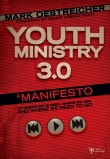 I’ve been wrestling with the concepts of Marko’s book, Youth Ministry 3.0 for a long time. Actually, before I worked a YS I had been going through a prolonged set of discussions at Romeo saying in a thousand different ways… What I’m doing isn’t working anymore.
I’ve been wrestling with the concepts of Marko’s book, Youth Ministry 3.0 for a long time. Actually, before I worked a YS I had been going through a prolonged set of discussions at Romeo saying in a thousand different ways… What I’m doing isn’t working anymore.
The problem was simple. I was trained and experienced at how to do youth ministry a certain way. The entire ministry was built around a youth group night of games, worship, small groups, and a talk. I had seen it work and do incredible things! Even in Romeo we had seen this ministry model draw 40+ students to a church of 120. Lives were changed, kids were discipled, volunteers loved it, on and on. We ran that thing and worked that model like a well-oiled machine. I was well-versed in all the terminology of all the other well-oiled youth ministry systems and had written tons comparing and contrasting the strength of one model over the other. But in the last few years the model tanked. Kids stopped coming. The whole thing became kind of toxic. Instead of re-arranging their schedule to make in on Wednesday night all of a sudden kids were trying to find things to do on Wednesday night so they could politely bow out. Frustration mounted and I kept saying, “What I’m doing isn’t working anymore.”
The crazy thing was my reaction to a YM 2.0 model. My response was always, even to the last day, “I know this works, something is just missing, that’s all.” I would tweak things here, re-emphasize this or that. It was never that the concept was broken. The problem was always either the kids not getting the vision of the model or my model not having the funding/support it needed to succeed. It never really dawned on me that my solution to fixing things was to kill the model and search for a better way to minister to students. My reaction was always to just work harder and to keep trying.
Pray more, blame the parents. Pray more, blame the money. Pray more, blame myself. Pray more, blame the kids busyness. In the end I was royally frustrated and a little angry at God that He had me in a place where I couldn’t fix things.
But as Marko’s book shows, there is a massive shift from what he calls “Youth Ministry 2.0” built around programs and models, towards “Youth Ministry 3.0” where the programmatic approach is, probably though not necessarily, foregone for a draw towards ministries built around affinity. (A super over-simplified analysis, right there!)
My wrestling point right now is pretty simple… how do I help ministries kill what has worked for a generation and open their eyes to a way to reach this generation. My experience in YM 2.0 environments is that they’d be happy running an un-attended YM 2.0 model if that means they don’t have to change things. Youth workers may not like the sacred cows of big church but they have certainly built some sacred cows themselves. (Remember the fury over my articles, “I Kissed Retreats Goodbye?“)
From a national perspective I’m seeing one trend that is scaring me and I don’t want it to be the solution: Killing youth ministry budgets, staffs, and programs. Please tell me that we’re not going to throw the baby out with the bath water? Simply because a model isn’t working doesn’t mean that we shouldn’t minister to adolescents!
What is a more productive outcome than that?
Leave a Reply